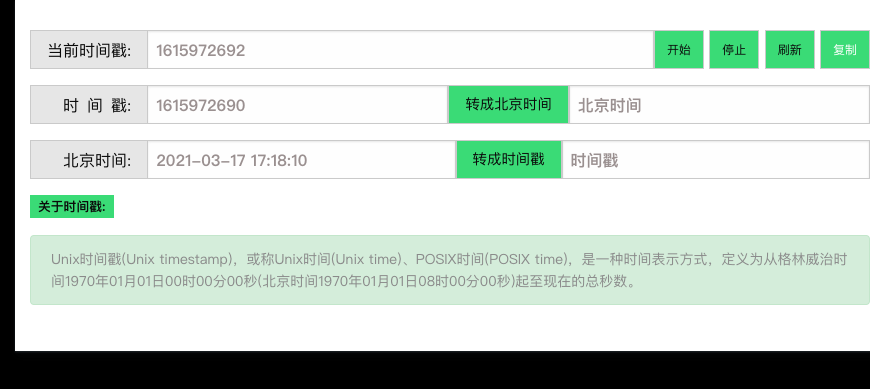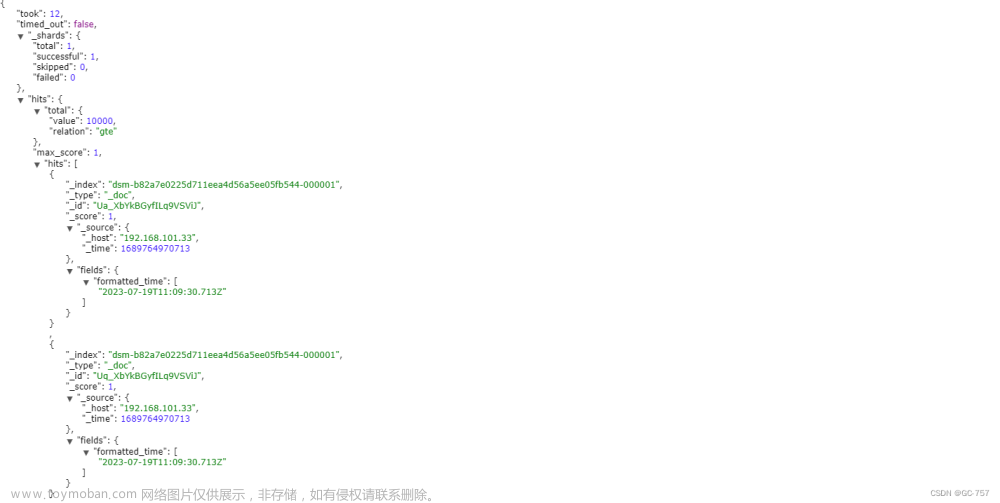本文转载自:springboot:时间格式化的5种方法(解决后端传给前端的时间显示不一致)_为什么前端格式化日期了后端还要格式化_洛泞的博客-CSDN博客
时间问题演示
为了方便演示,我写了一个简单 Spring Boot 项目,其中数据库中包含了一张 userinfo 表,它
的组成结构和数据信息如下:

项目目录是这样的:

UserController 实现代码如下:
@RestController
@RequestMapping("/user")
publicclass UserController {
@Resource
private UserMapper userMapper;
@RequestMapping("/list")
public List<UserInfo> getList() {
return userMapper.getList();
}
}
UserMapper 实现代码如下:
@Mapper
public interface UserMapper {
public List<UserInfo> getList();
}
UserInfo 实现代码如下:
@Data
publicclass UserInfo {
privateint id;
private String username;
private Date createtime;
private Date updatetime;
}
UserMapper.xml 实现代码如下:
<?xml version="1.0" encoding="UTF-8"?>
<!DOCTYPE mapper PUBLIC "-//mybatis.org//DTD Mapper 3.0//EN""http://mybatis.org/dtd/mybatis-3-mapper.dtd">
<mapper namespace="com.example.demo.mapper.UserMapper">
<select id="getList" resultType="com.example.demo.model.UserInfo">
select * from userinfo
</select>
</mapper>
经过以上内容的编写,我们就制作出了一个简单的 Spring Boot 项目了。接下来,我们使用 PostMan 来模拟调用 UserController 接口,执行结果如下:

从上述结果可以看出,时间字段 createtime 和 updatetime 的显示方式是很“凌乱”的,并不符合我们的阅读习惯,也不能直接展示给前端的用户使用,这时候,我们就需要对时间进行格式化处理了。
时间格式化的方法总共包含以下 5 种。
1.前端时间格式化
JS 版时间格式化
假设您有一个名为`data`的数组,其中包含后端响应的数据,其中包含了`createdTime`字段
"createdTime": { "nano": 0, "year": 2021, "monthValue": 12, "dayOfMonth": 16, "hour": 5, "minute": 54, "second": 45, "dayOfWeek": "THURSDAY", "dayOfYear": 350, "month": "DECEMBER", "chronology": { "id": "ISO", "calendarType": "iso8601" } }
,您可以像这样在el-table中显示它:
'''vue
<template> <div> <el-table :data="data"> <el-table-column label="创建时间"> <template slot-scope="scope"> {{ formatDate(scope.row.createdTime) }} </template> </el-table-column> <!-- 其他列 --> </el-table> </div> </template> <script> export default { data() { return { data: [], // 后端响应的数据 }; }, methods: { formatDate(timestamp) { // 使用JavaScript的Date对象将时间戳格式化为某年-某月-某日 某时:某分:某秒 const date = new Date(timestamp.year, timestamp.monthValue - 1, timestamp.dayOfMonth, timestamp.hour, timestamp.minute, timestamp.second); const year = date.getFullYear(); const month = (date.getMonth() + 1).toString().padStart(2, '0'); // 补零 const day = date.getDate().toString().padStart(2, '0'); const hours = date.getHours().toString().padStart(2, '0'); const minutes = date.getMinutes().toString().padStart(2, '0'); const seconds = date.getSeconds().toString().padStart(2, '0'); return `${year}-${month}-${day} ${hours}:${minutes}:${seconds}`; }, }, }; </script>'''
2.SimpleDateFormat格式化(Date)
使用 SimpleDateFormat 来进行时间格式化,它也是 JDK 8 之前重要的时间格式化方法,它的核心实现代码如下:
// 定义时间格式化对象和定义格式化样式
SimpleDateFormat dateFormat = new SimpleDateFormat("yyyy-MM-dd HH:mm:ss");
// 格式化时间对象
String date = dateFormat.format(new Date())
接下来我们使用 SimpleDateFormat 来实现一下本项目中的时间格式化,它的实现代码如下:
@RequestMapping("/list")
public List<UserInfo> getList() {
// 定义时间格式化对象
SimpleDateFormat dateFormat = new SimpleDateFormat("yyyy-MM-dd HH:mm:ss");
List<UserInfo> list = userMapper.getList();
// 循环执行时间格式化
list.forEach(item -> {
// 使用预留字段 ctime 接收 createtime 格式化的时间(Date->String)
item.setCtime(dateFormat.format(item.getCreatetime()));
item.setUtime(dateFormat.format(item.getUpdatetime()));
});
return list;
}
程序执行结果如下:

从上述结果可以看出,时间格式化没有任何问题,以及到底我们预想的目的了。但细心的读者会发现,为什么接口的返回字段咋变了呢?(之前的字段是 createtime 现在却是 ctime…)
这是因为使用 #SimpleDateFormat.format 方法之后,它返回的是一个 String 类型的结果,而我们之前的 createtime 和 updatetime 字段都是 Date 类型的,因此它们是不能接收时间格式化得结果的。
所以此时我们就需要在实体类 UserInfo 新增两个字符串类型的“时间”字段,再将之前 Data 类型的时间字段进行隐藏,最终实体类 UserInfo 的实现代码如下:
import com.fasterxml.jackson.annotation.JsonIgnore;
import lombok.Data;
import java.util.Date;
@Data
publicclass UserInfo {
privateint id;
private String username;
@JsonIgnore// 输出结果时隐藏此字段
private Date createtime;
// 时间格式化后的字段
private String ctime;
@JsonIgnore// 输出结果时隐藏此字段
private Date updatetime;
// 时间格式化后的字段
private String utime;
}
我们可以使用 @JsonIgnore 注解将字段进行隐藏,隐藏之后的执行结果如下:

3.DateTimeFormatter格式化
JDK 8 之后,我们可以使用 DateTimeFormatter 来替代 SimpleDateFormat,因为 SimpleDateFormat 是非线程安全的,而 DateTimeFormatter 是线程安全的,所以如果是 JDK 8 以上的项目,尽量使用 DateTimeFormatter 来进行时间格式化。
DateTimeFormatter 格式化的代码和 SimpleDateFormat 类似,具体实现如下:
@RequestMapping("/list")
public List<UserInfo> getList() {
// 定义时间格式化对象
DateTimeFormatter dateFormat = DateTimeFormatter.ofPattern("yyyy-MM-dd HH:mm:ss");
List<UserInfo> list = userMapper.getList();
// 循环执行时间格式化
list.forEach(item -> {
// 使用预留字段 ctime 接收 createtime 格式化的时间(Date->String)
item.setCtime(dateFormat.format(item.getCreatetime()));
item.setUtime(dateFormat.format(item.getUpdatetime()));
});
return list;
}
执行结果如下所示:

DateTimeFormatter 和 SimpleDateFormat 在使用上的区别是 DateTimeFormatter 是用来格式化 JDK 8 提供的时间类型的,如 LocalDateTime,而 SimpleDateFormat 是用来格式化 Date 类型的,所以我们需要对 UserInfoer 实体类做如下的修改:
import com.fasterxml.jackson.annotation.JsonIgnore;
import lombok.Data;
import java.time.LocalDateTime;
@Data
publicclass UserInfo {
privateint id;
private String username;
@JsonIgnore
private LocalDateTime createtime;
private String ctime;
@JsonIgnore
private LocalDateTime updatetime;
private String utime;
}
我们可以使用 LocalDateTime 来接收 MySQL 中的 datetime 类型。
4.全局时间格式化
以上两种后端格式化的实现都有一个致命的缺点,它们在进行时间格式化的时候,都需要对核心业务类做一定的修改,这就相当为了解决一个问题,又引入了一个新的问题,那有没有简单一点、优雅一点的解决方案呢?
答案是:有的。我们可以不改任何代码,只需要在配置文件中设置一下就可以实现时间格式化的功能了。
一、Date全局格式配置
首先,我们找到 Spring Boot 的配置文件 application.properties(或 application.yml),只需要在 application.properties 配置文件中添加以下两行配置:
'''properties
# 格式化全局时间字段
spring.jackson.date-format=yyyy-MM-dd HH:mm:ss
# 指定时间区域类型
spring.jackson.time-zone=GMT+8'''
这样设置之后,我们将原始的 UserInfo 和 UserController 进行还原。
UserInfo 实现代码如下:
import lombok.Data;
import java.util.Date;
@Data
publicclass UserInfo {
privateint id;
private String username;
private Date createtime;
private Date updatetime;
}
UserController 实现代码:
@RequestMapping("/list")
public List<UserInfo> getList() {
return userMapper.getList();
}
然后我们运行程序,看到的执行结果如下:

从以上结果和代码可以看出,我们只需要在程序中简单配置一下,就可以实现所有时间字段的格式化了。
二、@JsonFormat 注解(LocalDateTime全局格式配置)
@JsonFormat 注解方式严格意义上不能叫全局时间格式化,应该叫部分格式化,因为@JsonFormat 注解需要用在实体类的时间字段上,而只有使用相应的实体类,对应的字段才能进行格式化。
@Data
public class OrderDTO {
@JsonFormat(locale = "zh", timezone = "GMT+8", pattern = "yyyy-MM-dd")
private LocalDateTime createTime;
@JsonFormat(locale = "zh", timezone = "GMT+8", pattern = "yyyy-MM-dd HH:mm:ss")
private Date updateTime;
}
实现原理分析
为什么在配置文件中设置一下,就可以实现所有时间字段的格式化了呢?
'''properties
# 格式化全局时间字段
spring.jackson.date-format=yyyy-MM-dd HH:mm:ss
# 指定时间区域类型
spring.jackson.time-zone=GMT+8'''
这是因为 Controller 在返回数据时,会自动调用 Spring Boot 框架中内置的 JSON 框架 Jackson,对返回的数据进行统一的 JSON 格式化处理,在处理的过程中它会判断配置文件中是否设置了“spring.jackson.date-format=yyyy-MM-dd HH:mm:ss”,如果设置了,那么 Jackson 框架在对时间类型的字段输出时就会执行时间格式化的处理,这样我们就通过配置来实现全局时间字段的格式化功能了。
为什么要指定时间区域类型“spring.jackson.time-zone=GMT+8”呢?
最现实的原因是,如果我们不指定时间区域类型,那么查询出来的时间就会比预期的时间少 8 个小时,这因为我们(中国)所处的时间区域比世界时间少 8 个小时导致的,而当我们设置了时区之后,我们的时间查询才会和预期时间保持一致。
GMT 是什么?
时间区域设置中的“GMT” 是什么意思?
Greenwich Mean Time (GMT) 格林尼治时间,也叫做世界时间。
格林尼治时间
格林尼治是英国伦敦南郊原皇家格林尼治天文台所在地,地球本初子午线的标界处,世界计算时间和经度的起点。以其海事历史、作为本初子午线的标准点、以及格林尼治时间以其命名而闻名于世。这里地势险要,风景秀丽,兼具历史和地方风情,也是伦敦在泰晤士河的东方门户。
不光是天文学家使用格林尼治时间,就是在新闻报刊上也经常出现这个名词。我们知道各地都有各地的地方时间。如果对国际上某一重大事情,用地方时间来记录,就会感到复杂不便.而且将来日子一长容易搞错。因此,天文学家就提出一个大家都能接受且又方便的记录方法,那就是以格林尼治的地方时间为标准。
以本初子午线的平子夜起算的平太阳时。又称格林尼治平时或格林尼治时间。各地的地方平时与世界时之差等于该地的地理经度。1960年以前曾作为基本时间计量系统被广泛应用。由于地球自转速率曾被认为是均匀的,因此在1960年以前,世界时被认为是一种均匀时。由于地球自转速度变化的影响,它不是一种均匀的时间系统,它与原子时或力学时都没有任何理论上的关系,只有通过观测才能对它们进行比较。后来世界时先后被历书时和原子时所取代,但在日常生活、天文导航、大地测量和宇宙飞行等方面仍属必需;同时,世界时反映地球自转速率的变化,是地球自转参数之一,仍为天文学和地球物理学的基本资料。
5.部分时间格式化
某些场景下,我们不需要对全局的时间都进行统一的处理,这种情况我们可以使用注解的方式来实现部分时间字段的格式化。
我们需要在实体类 UserInfo 中添加 @JsonFormat 注解,这样就可以实现时间的格式化功能了,实现代码如下:
import com.fasterxml.jackson.annotation.JsonFormat;
import lombok.Data;
import java.util.Date;
@Data
publicclass UserInfo {
privateint id;
private String username;
// 对 createtime 字段进行格式化处理
@JsonFormat(locale = "zh", timezone = "GMT", pattern = "yyyy-MM-dd")
private Date createtime;
private Date updatetime;
}
修改完代码之后,我们运行项目执行结果如下:

从上述结果可以看出,使用注解的方式也可以实现时间的格式化。它的实现原理和第 4 种时间格式化的实现原理类似,都是在返回数据之前,对相应的字段进行时间格式化的处理。
总结
本文我们介绍了 5 种时间格式化的实现方法,其中第 1 种为前端时间格式化的方法,后 4 种为后端格式化的方法,SimpleDateFormat 和 DateTimeFormatter 格式化的方法更适用普通的 Java 项目,其中 SimpleDateFormat 是非线程安全的,而 DateTimeFormatter 是线程安全的,但它们都不是 Spring Boot 项目中最优的时间格式化方案。文章来源:https://www.toymoban.com/news/detail-692807.html
如果是 Spring Boot 的项目,推荐使用第 4 种全局时间格式化或第 5 种局部时间格式化的方式,这两种实现方式都无需修改核心业务代码,只需要简单的配置一下,就可以完成时间的格式化功能了。
————————————————
原文链接:https://blog.csdn.net/qq_41366629/article/details/118972757文章来源地址https://www.toymoban.com/news/detail-692807.html
到了这里,关于springboot:时间格式化的5种方法(解决后端传给前端的时间格式转换问题)推荐使用第4和第5种!的文章就介绍完了。如果您还想了解更多内容,请在右上角搜索TOY模板网以前的文章或继续浏览下面的相关文章,希望大家以后多多支持TOY模板网!









